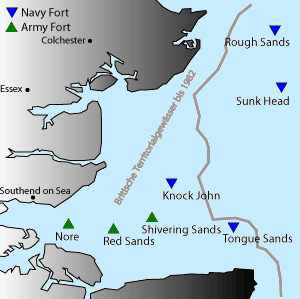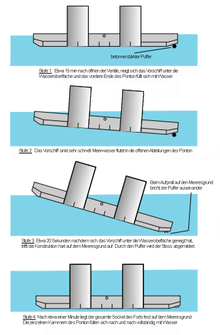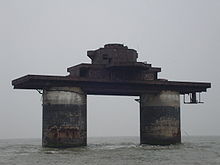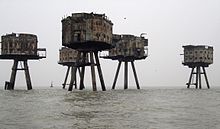Maunsell forts
The Maunsell Forts or Maunsell Sea Forts (in German: Maunsell Sea Fortifications ) are a group of artificial platforms and fortified towers that were built by the British military off the English east coast in the shallow waters of the estuaries of the Thames and on the west coast in the Mersey during the Second World War -Mouth (Liverpool Bay) were built. The name is reminiscent of the designer of these systems, the civil engineer Guy Maunsell .
Not all fortresses have been preserved. Today only Roughs Tower ( Roughs Sands ), Red Sands , Shivering Sands and Knock John exist .
The fortress Roughs Tower, which is held by a group led by Paddy Roy Bates (1921–2012), who took it over in 1967 and declared it the independent Principality of Sealand , gained great fame .
planning
The architect Guy Maunsell had the idea of using sea fortresses for coastal defense very early on, and submitted numerous designs to the British Admiralty at the beginning of the war. However, it was not until October 1940 that he was commissioned to draw up concrete plans for a new type of sea fortress. It should be dragged into the Thames estuary and lowered in a targeted manner at the desired position. A permanent crew should be able to be stationed on the part protruding above the water surface in order to protect the south coast against sea and air attacks.
The design developed by Maunsell envisaged using a buoyant pontoon as a base and reinforcing it with concrete . The construction thus remained buoyant. At the desired destination, the pontoon should then be flooded with sea water so that the structure sinks to the sea floor. The concrete would then soften the impact and at the same time ensure that it is firmly embedded in the seabed. However, the plans were initially not implemented.
Only with the German campaign in the west against the Netherlands , Belgium , Luxembourg and finally the success against France did the Admiralty return to Maunsell . Especially after German air strikes increased significantly and the previous protection of shipping routes appeared to be lossy and not effective enough, permanent defensive devices should be installed.
Work initially began under the name Thames Estuary Special Defense Units (TESDU). The constructions were later given the code name Uncle (U) and were numbered consecutively. Their longer names come from the sandbanks on which the forts were placed in order to ensure the stability of the construction and a sufficiently shallow water depth.

Maunsell was awarded a contract to design five defense platforms for the Royal Navy . They were to be similar to the first plans, but with additional heavy artillery and to accommodate a 100-man crew with supplies for more than a month. Their task was to prevent the German Air Force from mining the shipping lanes to London and to report all attempts.
Each of these fortresses rests on a concrete-reinforced pontoon on the sea floor, above two hollow concrete cylinders that were constructed with several floors inside. Above it was a relatively simple platform, each equipped with two 3.7 "(94 mm) -MK2c anti-aircraft guns and two 40-mm Bofors anti-aircraft guns.
Of the originally planned five forts, only four were built for unknown reasons.
- (U1) Roughs Tower was placed on the Rough Sands sandbank on February 11, 1942 .
51 ° 53 ′ 40 " N , 1 ° 28 ′ 57" E - (U2) Sunk Head Tower, sometimes jokingly referred to as Churchill One , followed in early June 1942.
51 ° 46 ′ 51 ″ N , 1 ° 30 ′ 21 ″ E - (U3) Tongue Sands was completed on June 17, 1942 and towed into position ten days later.
51 ° 29 ′ 55 " N , 1 ° 22 ′ 11" E - (U4) Knock John Tower was completed on July 16, 1942 and reached its position on August 1, 1942.
51 ° 33 ′ 42 ″ N , 1 ° 9 ′ 40 ″ E
Maunsell Army forts
Following the completion of the fortresses for the Navy, Maunsell received another contract. He was to design six new constructions for the British Army , three of which were each intended for the mouth of the Thames and the Mersey . They were now to be used directly for the anti-aircraft defense of German bombers whose attacks threatened the London shipyards upstream .
His design finally envisaged seven two-story towers for each fortress, which were only to be connected by catwalks made of steel tubes: a tower with a control station surrounded by four towers with MK6-3.7 "cannons, and a tower with two 40 mm Bofors guns and a little to the side a turret with searchlights . The turrets were thus able to reproduce the scheme of land-based anti-aircraft positions. However, it was not possible to use a construction with a pontoon again, as the sandbank was too strong under the influence of ebb and flow Maunsell had to design a new base that would allow the sand to move without changing the position of the towers too much.
Construction of the three new fortresses in the Thames estuary began as early as August 1942 , and by December 1943 all towers were installed at their destination.
- (U5) Nore, between May and July 1943.
51 ° 25 ′ 45 ″ N , 0 ° 50 ′ 0 ″ E - (U6) Red Sands, between July and November 1943.
51 ° 28 ′ 6 ″ N , 0 ° 59 ′ 6 ″ E - (U7) Shivering Sands , between September and December 1943
51 ° 29 ′ 57 ″ N , 1 ° 4 ′ 29 ″ E
Three more forts were built on schedule in the mouth of the Mersey.
Construction and military use
All forts were built in dry dock on Red Lion Wharf . Completed in relatively short succession between February 1942 and December 1943, they were towed to their target positions and sunk one after the other. They did full duty until a month after the end of the war. Allegedly the sea fortresses in the Thames estuary alone destroyed a speedboat , 22 planes and 31 V1 wing bombs during World War II .
After the end of the war, however, the fortresses were no longer needed. As early as June 14, 1945, all stations were shut down and the crew reduced to smaller teams for maintenance and repairs.
By the end of the 1950s , the stations were gradually abandoned, the guns dismantled and the last crews withdrawn completely.
Subsequent years
Several platforms were lost in the following years:
- On March 1, 1953, two towers of Nore were destroyed in a collision by the Swedish ship Baalbeck . After the Mairoula M collided with the station in 1954 , the remaining rubble was viewed as a danger to shipping. By 1960 the entire superstructure was dismantled and towed off the coast at Alpha Wharf, Kent , where the debris can still be seen today. The concrete stilts were blown up.
- On June 7, 1963, the coastal ship Ribersborg collided with Fort Shivering Sands, which destroyed a gun turret.
- Sunk Head was demolished in the 1960s shortly after the occupation of Rough Sands, presumably to prevent further occupation here.
- Tongue Sands collapsed during a storm in 1996 after being damaged for a long time.
From 1964 to 1967, several pirate stations occupied the abandoned platforms:
- On 27 May 1964 launched Screaming Lord Sutch with Radio Sutch from a gun turret on Shivering Sands .
- Von Red Sands initially broadcasted Radio Invicta, later renamed KING Radio , before Ted Allbeury broadcast the much more professional Radio 390 on a wavelength of around 390 meters. The Danger Man episode "Not-so-Jolly Roger" was partially shot on Red Sands in 1966 and the film team thanks Radio 390 in the credits. Red Sands is now privately owned.
- A group of radio enthusiasts founded Radio Tower on Sunk Head, but could not survive financially and gave up after a few months.
- Paddy Roy Bates captured Knock John from the operators of Radio City, who intended to move there, and broadcast Radio Essex from October 1965 , later renamed Britain's Better Music Station until December 25, 1966.
Roughs Tower has been occupied by Paddy Roy Bates and his successors since 1967 . Bates had then founded the Principality of Sealand .
The Seatribe project is trying to save the other platforms, which are now about to be demolished.
literature
- Frank R. Turner:
- The Maunsell Army Sea Forts of the Thames Estuary ( ISBN 1-901132-14-5 ); revised edition 2001, Gravesend
- The Maunsell Sea Forts ( ISBN 0-952430-30-4 ); 1996, Gravesend
- Seafort ( ISBN 978-0955457302 ), 2006, published by 'The Seafort Project' (96 pages)
Web links
Information and pictures:
- gnometech
- Maunsell Naval Sea Fort "Knock John" undergroundkent.co.uk
- Maunsell Army Sea Forts "Red Sands / Shivering Sands" undergroundkent.co.uk
- mongsoft
- ecastles
- "Fort Fanatics" by Bob Le-Roi
- Article "Madness on the water" on SPON / one day
Projects:
Individual evidence
- ↑ Note. On the sandbank Roughs Sands sitting is the Fort Roughs Tower or Roughs Sands called
- ↑ Annette Dittert: "Extra-Terrestrial" at the Thames estuary. ARD London / DasErste.de, October 24, 2010, archived from the original on October 26, 2010 ; Retrieved February 26, 2011 .




